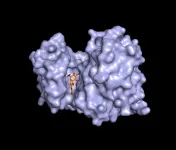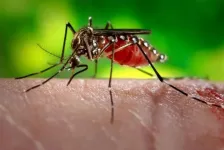(Press-News.org) DALLAS - Feb. 22, 2021 - Three decades-old antibiotics administered together can block a type of pain triggered by nerve damage in an animal model, UT Southwestern researchers report. The finding, published online today in PNAS, could offer an alternative to opioid-based painkillers, addictive prescription medications that are responsible for an epidemic of abuse in the U.S.
Over 100 million Americans are affected by chronic pain, and a quarter of these experience pain on a daily basis, a burden that costs an estimated $600 billion in lost wages and medical expenses each year. For many of these patients - those with cancer, diabetes, or trauma, for example - their pain is neuropathic, meaning it's caused by damage to pain-sensing nerves.
To treat chronic pain, prescriptions for opioid painkillers have increased exponentially since the late 1990s, leading to a rise in abuse and overdoses. Despite the desperate need for safer pain medications, development of a new prescription drug typically takes over a decade and more than $2 billion according to a study by the Tufts Center for the Study of Drug Development, explains study leader Enas S. Kandil, M.D., associate professor of anesthesiology and pain management at UTSW.
Seeking an alternative to opioids, Kandil and her UT Southwestern colleagues - including Hesham A. Sadek, M.D., Ph.D., professor of internal medicine, molecular biology, and biophysics; Mark Henkemeyer, Ph.D., professor of neuroscience; Mahmoud S. Ahmed, Ph.D., instructor of internal medicine; and Ping Wang, Ph.D., a postdoctoral researcher - explored the potential of drugs already approved by the Food and Drug Administration (FDA).
The team focused on EphB1, a protein found on the surface of nerve cells, which Henkemeyer and his colleagues discovered during his postdoctoral training nearly three decades ago. Research has shown that this protein is key for producing neuropathic pain. Mice genetically altered to remove all EphB1 don't feel neuropathic pain, he explains. Even mice with half the usual amount of this protein are resistant to neuropathic pain, suggesting EphB1's promise as a target for pain-relieving drugs. Unfortunately, no known drugs inactivate EphB1.
Exploring this angle further, Ahmed used computer modeling to scan a library of FDA-approved drugs, testing if their molecular structures had the right shape and chemistry to bind to EphB1. Their search turned up three tetracyclines, members of a family of antibiotics used since the 1970s. These drugs - demeclocycline, chlortetracycline, and minocycline - have a long history of safe use and minimal side effects, Ahmed says.
To investigate whether these drugs could bind to and inactivate EphB1, the team combined the protein and these drugs in petri dishes and measured EphB1's activity. Sure enough, each of these drugs inhibited the protein at relatively low doses. Using X-ray crystallography, Wang imaged the structure of EphB1 with chlortetracycline, showing that the drug fits neatly into a pocket in the protein's catalytic domain, a key portion necessary for EphB1 to function.
In three different mouse models of neuropathic pain, injections of these three drugs in combination significantly blunted reactions to painful stimuli such as heat or pressure, with the triplet achieving a greater effect at lower doses than each drug individually. When the researchers examined the brains and spinal cords of these animals, they confirmed that EphB1 on the cells of these tissues had been inactivated, the probable cause for their pain resistance. A combination of these drugs might be able to blunt pain in humans too, the next stage for this research, says Kandil.
"Unless we find alternatives to opioids for chronic pain, we will continue to see a spiral in the opioid epidemic," she says. "This study shows what can happen if you bring together scientists and physicians with different experience from different backgrounds. We're opening the window to something new."
INFORMATION:
Sadek holds the J. Fred Schoellkopf, Jr. Chair in Cardiology. Henkemeyer holds the Dick and Martha Brooks Professorship in Nerve Growth Research.
Other researchers who contributed to this study include Ngoc Uyen Nhi Nguyen, Yuji Nakada, Ivan Menendez-Montes, and Robert Bachoo, all of UTSW; Yuji Nakada of the University of Alabama at Birmingham, and Muhammad Ismail of The British University in Egypt.
This study was funded by the Hamon Center for Regenerative Science and Medicine at UT Southwestern Medical Center.
About UT Southwestern Medical Center
UT Southwestern, one of the premier academic medical centers in the nation, integrates pioneering biomedical research with exceptional clinical care and education. The institution's faculty has received six Nobel Prizes, and includes 23 members of the National Academy of Sciences, 17 members of the National Academy of Medicine, and 13 Howard Hughes Medical Institute Investigators. The full-time faculty of more than 2,500 is responsible for groundbreaking medical advances and is committed to translating science-driven research quickly to new clinical treatments. UT Southwestern physicians provide care in about 80 specialties to more than 105,000 hospitalized patients, nearly 370,000 emergency room cases, and oversee approximately 3 million outpatient visits a year.
Scientists have identified a way to "rescue" muscle cells that have genetically mutated, paving the way to a possible new treatment for rare childhood illness such as Duchenne Muscular Dystrophy (DMD).
The study, led by the Universities of Exeter and Nottingham, is published in the Proceedings of the National Academies of Sciences, USA. The research used novel drugs being developed at the University of Exeter, which "metabolically reprogram" the cellular energy production centres in muscle cells, by providing them with a fuel source to generate metabolic energy.
DMD is a genetic condition caused by a mutation in a gene called dystrophin which results in progressive irreversible muscular degeneration and weakening. Its symptoms include muscle ...
Things just got hairy at Princeton.
Researchers found they could coat a liquid elastic on the outside of a disc and spin it to form useful, complex patterns. When spun just right, tiny spindles rise from the material as it cures. The spindles grow as the disc accelerates, forming a soft solid that resembles hairs.
Inspired by biological designs and rationalized with mathematical precision, the new method could be used at an industrial scale for production with plastics, glasses, metals and smart materials.
The researchers published their findings ...
(Boston)--Tau is a protein that helps stabilize the internal skeleton of nerve cells (neurons) in the brain. Groups of toxic tau protein, termed tau oligomers, drive disease progression and memory loss in Alzheimer's disease (AD). A new study from Boston University School of Medicine (BUSM) shows how these tau oligomers form, and, correspondingly, how they can be prevented.
AD is a major cause of disease in the elderly and places a huge financial cost on the health care system. Scientists have known for a long time that two proteins (?-amyloid and tau) clump and accumulate in the brains ...
LOGAN, UTAH, USA -- You might not like mosquitoes, but they like you, says Utah State University biologist Norah Saarman. And where you lead, they will follow.
In addition to annoying bites and buzzing, some mosquitoes carry harmful diseases. Aedes aegypti, the so-called Yellow Fever mosquito and the subject of a recent study by Saarman and colleagues, is the primary vector for transmission of viruses causing dengue fever, chikungunya and Zika, as well as yellow fever, in humans.
"Aedes aegypti is an invasive species to North America that's become widespread in the eastern United States," says Saarman, assistant professor in USU's Department of Biology and the USU Ecology Center, whose research focuses ...
Adolescents and teens may be more likely to be bullied by their friends -- and friends-of-friends -- than classmates they don't know as well, according to a new study.
Diane Felmlee, Distinguished Professor of Sociology and Demography at Penn State and researcher on the paper, said the findings give new insight into how and why bullying occurs -- important information for anti-bullying efforts.
"People often assume that bullying occurs between relative strangers, or that it targets those on the fringes of the social network," Felmlee said. "Those do occur, but in our study, we find that the rate of peer aggression is significantly higher between those students who are closely linked. Furthermore, our finding is not due to friends simply spending ...
In a new study out of University of California San Diego School of Medicine, researchers have identified a universal strain of bacteria derived from healthy human skin that can treat the most common type of eczema, also known as atopic dermatitis.
In the paper published Feb. 22, 2021, in Nature Medicine, the research team investigated the safety and mechanisms of this certain bacteria in a first-in-human, Phase I, double-blinded clinical trial looking to treat people living with eczema. Of the 54 participants, two-thirds reported improvements in their ...
The diversity and numbers of wild salmon in Northern B.C. have declined approximately 70 per cent over the past century, according to a new Simon Fraser University study.
Researchers drawing on 100-year-old salmon scales report that recent numbers of wild adult sockeye salmon returning to the Skeena River are 70 per cent lower than 100 years ago. Wild salmon diversity in the Skeena watershed has similarly declined by 70 per cent over the last century.
The research undertaken by Simon Fraser University (SFU) and Fisheries and Oceans Canada was published today in the Journal of Applied Ecology.
The research team applied modern genetic tools to salmon scales collected from commercial ...
Boston, Mass. - Even with more than 1.5 million Americans receiving a COVID vaccine each day, officials estimate it will take many more months before enough people are protected from the deadly virus. Until then, and potentially beyond, experts agree that opening up schools, restaurants and other public places as safely as possible will rely on widespread testing for SARS-CoV-2, the virus that causes COVID-19.
As of June 2020, the U.S. Food and Drug Administration (FDA) had granted emergency use authorization for more than 85 different viral DNA test kits -- or assays -- each with widely varying degrees of sensitivity and unknown rates of accuracy. However, with no existing gold standard test for the novel coronavirus, there's little data on which ...
A paper recently published in the scientific journal Stem Cells and Development shares an important advancement in conservation -- one that may make the difference between survival and extinction for wildlife species that have been reduced to very small population sizes. Using fibroblast cells that have been preserved in San Diego Zoo Global's Frozen Zoo®, scientists have been able to generate induced pluripotent stem cells of northern and southern white rhinoceroses. This important breakthrough is the first step in a complex process for generating gametes from deceased and non-reproductive individuals of these two subspecies.
"For the northern white rhino, which is functionally extinct, the only hope for survival may be in the ...
ITHACA, N.Y. - Cornell University scientists have identified a new contender when it comes to quantum materials for computing and low-temperature electronics.
Using nitride-based materials, the researchers created a material structure that simultaneously exhibits superconductivity - in which electrical resistance vanishes completely - and the quantum Hall effect, which produces resistance with extreme precision when a magnetic field is applied.
"This is a beautiful marriage of the two things we know, at the microscale, that give electrons the most startling ...


